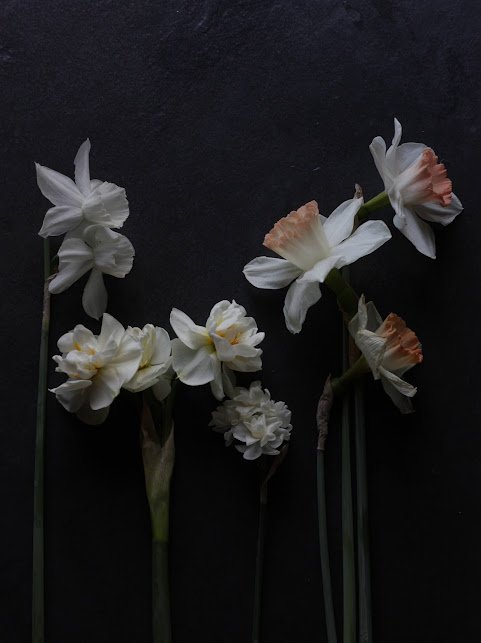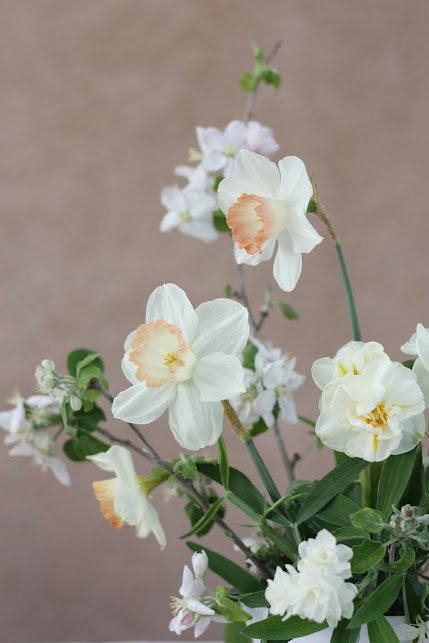Top Tips on How to Use (and Grow) Daffodils as a Flower Farmer
While tulips often get the focus and attention of spring flowers, daffodils should not be forgotten in the spring lineup!
A truly perennial spring-flowering bulb, daffodils are a great addition to any flower farmer especially for early spring sales. Some of the first flowers or plants to bloom in spring, they are as beautiful and graceful as any flower out there.
Here are some tips for working with daffodils and working them into your flower farm business
Plant them in the fall
Daffodils are planted in the fall and will bloom the following spring. Unlike tulips and hyacinths, they don't have as long chill period needed (8-10 weeks), and will bloom just fine and tall even in warmer climates or if planted a bit late (a reason why we favor them over tulips).Give them good drainage
Although daffodils are quite cold hardy (surviving temperatures down to well below 0 F even when the ground is frozen solid) but they can drown if kept in super soggy soil, especially in wet and boggy spring conditions.You don't have to worry about animal pests
Unlike tulips, daffodils taste pretty nasty to most animals. Voles, which are frequent predators of tulips and other flowering bulbs tend to leave daffodils alone, which makes them a lot easier to cultivate in practice.Choose varieties that have different flowering periods
There are a lot of varieties of daffodils, and not all of them bloom at the same time. The prototypical yellow 'Dutch Master' tulip for example, blooms in the middle of spring, while the fluffy 'Ice King' is an early bloomer (one of the earliest to be honest) while the lovely and fragrant 'Winston Churchill' blooms later. By choosing varieties that span the entire spring, you'll be able to have daffodils rolling through all season.Grow a variety of forms and sizes
A good variety of texture and forms makes for an appealing floral arrangement or design, and the same comes with daffodils. The tiny variety ‘Minnow’ is quite diminutive at 0.5” across and dainty with multiple blooms on each stem, while ‘British Gamble’ is the dinnerplate dahlia of the daffodil world at 5-6”. There are fluffy doubles, daffodils with long and elegant petals, and many that are the more traditional saucer shaped bloom. Growing a great mix of these will ensure that you have a good variety of blooms to mix into arrangements or bouquets or to sell on their own.Allow them to perennialize
Daffodils will naturally perennialize on their own, and unlike tulips (which need to be harvested like an annual because their bulbs will not produce a saleable flower in the future) they will reliably produce another high-quality bloom the next year. So the first year you’ll be able to recoup your expenses on the bulb by cutting and selling the first bloom, and then the next year the same bloom will be all profit.Allow them to multiply
Daffodils will not only perennialize but also multiply too! From just a single bulb, they will start multiplying (with each bulb continuing to produce a new flower in the future) and you’ll soon have a clump of daffodils where there was just a single bulb previously. This sort of multiplication is similar to dahlia tubers where you’ll get more and more plants and more and more blooms every year. Although the initial investment and planting and time is higher than say starting an annual from seed, they will continue to multiply and provide a reliable spring crop for you every year.You can interplant them with other flowers
Daffodils do quite well when interplanted with other flowers that grow in other times of the year. We have a lot of daffodils interplanted among other perennials and shrubs that don’t start actively growing until later in the year - when the daffodils are completely done and have gone dormant in the heat. You can also succession sow other flowers on top of a daffodil bed later in the year - celosia or other heat-loving shallow-rooted annuals are a great option - and watch the daffodils come up again the following spring. Just be careful not to uproot them of course!When harvesting, pull from the base instead of cutting
Daffodils are best harvested when firmly grasped at the base of the stem and pulled from between the leaves. This not only is easier and faster and cleaner than cutting with snips or scissors, from my experience it tends to reduce the sap that oozes from the base of the stemCut in the ‘gooseneck’ stage for longest vase life
When daffodils are fully open, they are already fading - you want to harvest them before they start to bloom. The correct stage is what is known as the ‘gooseneck’ stage - when the bud is fat and full and is still closed, hanging down at around a 30 degree angle from the stem towards the ground. When harvested this way and brought inside, they will open within around 24 hours and last for a good week or more.Allow for the sap to stop flowing after harvesting
Daffodils naturally produce a clear and sticky and mucilaginous sap when cut or harvested. This sap can be irritating to the skin and eyes and mucous membranes, and can also be harmful to other flowers included in an arrangement. Like any other sap-producing flower (like euphorbias) it’s best to harvest these types of flowers into a holding container to allow them to fully express their sap, then move them into their final arrangement or holding container after the sap has stopped flowing. Note that you’ll want to let the sap bleed off after making every fresh cut when designing.Leave the foliage to feed the bulb for next year
After flowering, daffodil bulbs will need to store up energy for the next year in the form of starch that forms in the bulb so it’s important to leave the foliage in place (or should I say to leave the leaves in place? :D) until it yellows and browns - showing that the energy from the leaves has been fully transported into the bulb and it will be ready to bloom the following yearPair with other spring materials
Daffodils are a great spring flower and combine well with other spring bloomers. Depending on what is blooming where you are at, they can be combined with dried flower and materials like cress and strawflowers or with woody stems like pussy willow or witch hazel or forsythia, or (in the later bloomers) fritillarias, ranunculus and anemones and tulips. A great focal flower, I find they work so well with so many other materials in spring.Or, just display them on their own
Daffodils also just work really well on their own, in a single bunch. Especially at this time of year when people are extremely “flower” hungry and starved for color and fresh flowers, even simple single yellow daffodils make a cheerful and attractive display when bunched and displayed as a straight bunch - no other materials needed.Kick off your growing season
Daffs are a great initial/first flower to offer your customers and clientele in the spring. As I mentioned, people are super flower-hungry in the spring and even a little posy or mason jar full of daffodils is a surefire way to bring some joy into someone’s life. It’s a great way to hook new customers or bring in income from existing customers first thing in the spring, and since daffodils are beloved by (almost) everyone they are a great first flower to offer.Make a daffodil share/CSA
A great way to sell daffodils (or other spring flower bulbs) is to include them in a flower share or a CSA subscription for a few weeks. This will allow you to pre-sell these blooms and ensure that the daffodils you are growing are already sold and all you have to worry about is distributing the flowers to their recipients (instead of worrying about marketing and selling them)Sell as potted flowers
Forced bulbs are a great sales item if you have the space and ability to do so. They still need a chill period, but will start to sprout and grow at around 45 F. With good light and a bit of heat they can be a lucrative product when priced correctly, or can be sold as a flower share/CSA subscription as well. Great for early farmer’s markets, especially if you live in a colder zone (and of course paperwhite (a variety of daffodil) are popular during the holidays and late winter).Sell in the fall as a bulb share
If you have the availability for a large wholesale order, you can also sell specialty daffodil bulbs in the fall to customers to plant in their own gardens or pots. Simply include them in a paper bag with planting instructions for your customers. And make sure to use some beautiful photography you’ve taken of your daffodils the previous year to sell them!Choose unique varieties
While you can grow the usual yellow daffodils that are ubiquitous to landscaping and sold in dry bunches at every grocery store, you may have success if you grow more unusual varieties that aren’t commonly seen by the average person. Unusual colors, double forms, and smaller/large varieties are usually a lot of fun to grow and really catch the eye.Don’t forget about scent!
If you haven’t smelled a scented daffodil, then you are truly missing out. One of the most gorgeous, heady scents in the flower world, they are on par with lilies and roses as some of the most beautifully scented flowers with a musky undertone (think paperwhites). Our favorites include ‘Thalia’, ‘Replete’, ‘Cheerfulness’, ‘Sir Winston Churchill’ and ‘Erlicheer’
And if you love daffodils as much as I do, here are a few other posts that you might enjoy!

